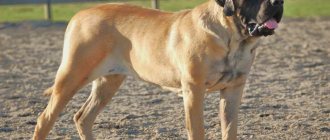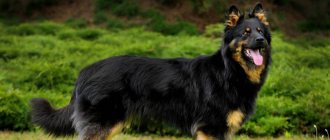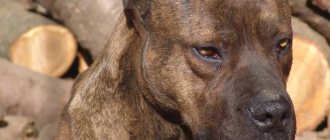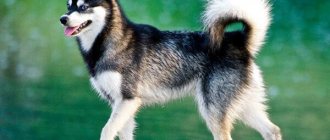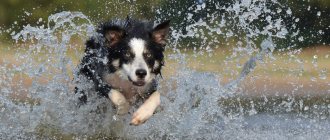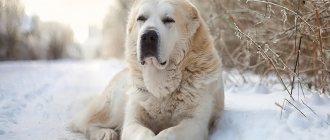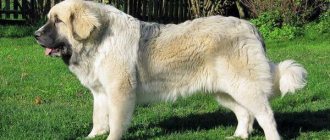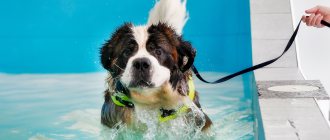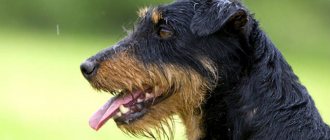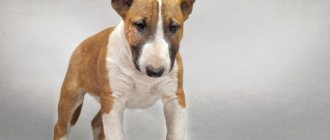Breed characteristics
| Short description | |
| Origin: | central Asia |
| Conditions of detention: | House with a garden, spacious house or apartment, aviary |
| Purpose: | Service dogs, working dogs, companion dogs, guard dogs |
| Color: | Different |
| Wool length: | Various |
| Adult dog size: | Height 62-65 cm, weight 40-90 kg |
| Average life expectancy: | 9-15 years |
| Walk: | Twice daily walk required |
| Physical activity needs: | High physical activity needs (regular or daily exercise for more than 3 hours per day) |
| Fédération Cynologique Internationale (FIC) classification: | Group 2: Pinschers and Schnauzers, Molossians, Mountain and Swiss Cattle Dogs; Section 2: Molossians |
| Puppy price: | From 20,000 to 160,000 rubles. The price depends on the specific breed. The most expensive is the Tibetan Mastiff |
History of the origin of the species
The origin of Mastiffs is still very poorly understood and established . It is believed that the first similar dogs were the Molossian Great Danes, which appeared in Central Asia. Roman legionnaires found and spread dogs across the continent. After this, different peoples began to carry out breeding work in order to improve the desired qualities of their pets. For example, Dogues de Bordeaux were excellent gladiators and poisoning dogs.
It is worth noting that all Mastiffs were gladiators and participated in battles. They were also often used as baiting animals (they hunted lions, bears, tigers). Some even went to war and formed the first ranks of the Roman army.
Cumberland Sheepdog
The Cumberland Sheepdog is the closest relative of the Border Collie. This gorgeous Australian Shepherd was a real hard worker. Her half-meter height and relatively low weight allowed her to move calmly, lightning-fast and almost silently across the ground. A distinctive feature of the breed was dense black and white fur, a muscular body and ears that constantly fall on the front of the head. You can safely call this dog one of the most charming.
WHO: the second year of the coronavirus pandemic may be more difficult
Barks and chews everything: a zoopsychologist told how to wean a dog from bad habits
Environmental activist Greta Thunberg will be featured on Swedish stamps
At the beginning of the last century, the breed began to be called border collies, which probably caused its extinction. She was grouped with another breed.
Distinctive features
All representatives of the Molosser section have similar typical features: a large, heavy body, a wrinkled muzzle, a wide skull, well-developed muscles and strong bones. There are 8 main types of Mastiffs and many similar breeds belonging to this section and group. A separate standard has been compiled for each type, but several general characteristics are distinguished.
- The head is square in shape with a strong angular skull, pronounced brow ridges and cheekbones;
- The muzzle is of medium length or shortened, can be upturned, and is always abundantly surrounded by wrinkles. The lips are soft, often jagged.
- The body is strong, voluminous, harmonious. The top line is straight, the bottom line is tucked in, but not completely.
- The limbs are strong, smooth, parallel limbs with large rounded paws and arched toes.
Talbot
Many experts are confident that this dog is the ancestor of the modern beagle and bloodhound. Talbot was an indispensable hunting dog, a popular sight in England during the Middle Ages. It is unclear whether this breed was bred as a greyhound or if they were used for digging up prey.
I make do with what I have: I made myself a “steamer” from sushi sticks
New cartoon “Ogonyok-Ognivo”: starring Natalya Tereshkova and Pyotr Kovrizhnykh
The girl decided to meet a foreigner. But his answer made me doubt
This breed has been illustrated in art. Dogs were depicted as either small or medium-sized, with white fur, huge, powerful paws, a thin waist, long drooping ears and a long curled tail. Talbot lived until the end of the eighteenth century.
Types of mastiffs with photos
English Mastiff
The largest of all representatives. His height is approximately 70-75 cm, and his weight is equal to 100 kg. Well built, muscular. The colors are different: peach, silver, beige. A distinctive feature is a black mask on the face and head. The coat is short.
Neapolitan Mastiff
The shoulder reaches 60-70 cm, weighs about 50 kg . The most graceful and majestic of the 8 representatives. Color: ash-black with a white spot on the chest. His muzzle is one of the most wrinkled of all Molossians.
Spanish Mastiff
A large representative, reaches 70-75 cm, weighs 80-85 kg. A characteristic difference is a short but thick coat like Alabai’s, and a skin dewlap on the neck. Color ranges from milky white to golden hazel.
Fila Brasileiro – Brazilian Mastiff
One of the best guards. It is distinguished by moderate aggressiveness and a fit, slender body. It is not as big as English or Spanish. Only 60 cm at the withers . Obedient, efficient, one of the few well-trained Molossians.
Bullmastiff
A wonderful pet. Small – 50-60 cm with a weight of 50-60 kg . Any color, characterized by a black mask, black spots on the ears and chest spots. Obtained as the result of a mating between a Bulldog and a Mastiff.
Dogue de Bordeaux
It also has a second name - French Mastiff . A distinctive feature is the only color - orange-red. This dog's muzzle is slightly upturned and has a characteristic black or red mask. In character he is no different from his brothers.
Japanese Great Danes (Tosa Inu)
The most original of the family is a rather stubborn breed. A distinctive feature is a small number of skin folds on the head and a narrow skull. Representatives are fit and slender. Miniature in weight (from 30 to 60 kg).
Tibetan mastiff
One of the most expensive breeds in the world. It has long, thick hair, thanks to which it can easily withstand frost. Considered the best dog of eastern origin.
Argentine White Mastiff
Another name for the dog is Dogo Argentino . Perfect for hunting and service. It has short snow-white fur, but slight darkening is allowed in the area of the ears and eyes.
Description of the breed
The English Mastiff, whose standard has been recognized by major canine organizations (FCI, UKF, FCI), is a strong, confident dog. She should be calm, courageous, wary, but without aggression, and treat strangers.
The minimum weight of an English Mastiff for a female is 54 kg, for a male – 68 kg. On average, a dog weighs 90 – 100 kg. At the withers it reaches 70–80 cm.
Frame
The description of the breed presents a strongly built dog with well-developed muscles. The sizes are large, the bones are wide. The dog is longer in length from scruff to tail than in height. The chest is wide, deep, its volume exceeds the height at the withers by 1/3. The dog gives the impression of great strength. Even the photo of an English Mastiff looks impressive.
The tail is sickle-shaped, large, tapering towards the end. When the dog is calm, it keeps the rod lowered, and when moving it raises it up to the back, but not higher.
Head
Square, with jowls and folds on the muzzle. When the pet concentrates, deep wrinkles gather on its forehead, giving it a menacing appearance.
The nose is large and black. The eyes are set wide apart, dark or hazel in color. The ears are dark or black, drooping, thin and soft, with rounded tips. The teeth, especially the fangs, are powerful. A direct or reverse scissor bite – with the lower jaw protruding slightly forward.
Limbs
Straight, set wide apart, parallel to each other. The joints are developed. The paw pads are balled up, arched, with black nails.
Coat and color
The coat is short, dense, and harsh. The undercoat is soft and dense. The English Mastiff dog breed has the following colors:
- apricot (red);
- fawn (deer);
- dark brindle - the so-called black English mastiff.
An accurate idea of the color will be formed after viewing a photo of an English mastiff.
Regardless of color, there should be a black mask on the face, and the ears and nose should be dark.
The breed standard classifies a small white spot on the chest as a fault. Excessively large white spots on the body, the absence of a mask or its asymmetry are disqualifying faults.
Features of character and behavior
All Mastiffs are phlegmatic by nature. They are not particularly active, they like to spend time in the company of their owner. They are suitable as a family dog and pose a threat to children only due to their impressive size. In case of danger, they are able to protect both the territory and the person, but they simply do not show aggression.
Advantages
The advantages of the breed include:
- Calmness, poise;
- Family life, homeliness (they will never run away, they like to be on their territory near close people);
- Obedience;
- Good-natured and phlegmatic (they treat children and pets well);
- Good physical characteristics;
- Security instincts (able to protect against intruders).
Flaws
Mastiffs have few disadvantages, including:
- Stubbornness and a certain waywardness;
- Touchiness;
- Dogs require training;
- They may show dislike for male dogs;
- Loneliness and change of environment are difficult to bear;
- Slobbery;
- They snore.
All dogs are individual in temperament. It all depends on upbringing and breed line. Even the sweetest and kindest dog can become aggressive due to rough treatment.
Care and maintenance
These dogs, although large, are unpretentious . They can get along in any territory and get used to any conditions. The most difficult to groom is the Tibetan Mastiff due to its long, thick mane. Other Mastiffs are short-haired. Such pets do not require much free space and can sleep on a bedding in the hallway. A special feature is not fussiness and unobtrusiveness. They will not interfere with their active games.
Street keeping of all (except Tibetan) dogs is possible only in warm climates. The animals are short-haired and can freeze. In winter, some are even dressed in protective overalls.
- Before buying a puppy, you need to make sure that the house is ready for the arrival of a new family member. The lounger should be installed in a place that is not subject to drafts. The height of the bowls is adjusted to the height of the pet. The number of toys depends on the dog's needs.
- Regarding eye care. Mastiffs are often prone to diseases in this particular area, so it is important to examine the mucous membranes daily and wipe them with chamomile decoction.
- The ears should also not be neglected; clean them as needed. You can purchase special chewing cords for your teeth, or you can wash your mouth with dog toothpastes yourself.
- Nails are rarely trimmed, only when absolutely necessary . Paws are wiped or washed after each walk. All dogs should be treated for fleas and ticks using solutions, shampoos and collars.
Nutrition
Mastiffs are large, strong dogs, but they do not need large amounts of food.
- Puppies are fed 5-6 times a day (up to 5 months);
- Adult pets are transferred to a one-time meal, usually in the evening. Usually 800 g of dry or natural food is enough for them.
- The best choice is dry grain-free food (holistic), which belongs to the highest class of products and is intended for active and large dogs.
Due to the fact that dogs came from wolves, they are predators and require a lot of meat: beef, rabbit, chicken. You can also give fermented milk products and boiled sea fish, after removing the bones. It is worthwhile to diversify their diet with various cereals, and this is also a fairly important component in their diet. It is allowed to give rice, oatmeal and buckwheat porridges boiled in milk, broth or water. You can add pieces of fruit or raw vegetables to them.
Prohibited products:
- Butter;
- Citrus;
- Onion garlic;
- Pork;
- Potatoes, melon and other starchy fruits and vegetables;
- Fried, salty, smoked, flour and sweet;
- Various bones.
You should not feed animals leftover food, as well as table scraps, as this can harm the pet. Maintaining proper nutrition will help your dog develop properly and maintain a strong immune system. Also, the mastiff should always have free access to clean drinking water.
Health
Most often, a pet's health depends on care and nutrition. Mastiffs are no exception. They have good natural immunity, but have several hereditary diseases and specific characteristics of the body. Life expectancy depends on the breed, on average from 9 to 15 years .
To avoid the early death of an animal, you need to regularly check it at a veterinary clinic, vaccinate it against viral diseases and follow all rules of care.
Vaccinations
At the age of 1.5 - 2 months, the Mastiff puppy should be vaccinated. Basically, this is done by nursery employees, but it should be understood that private individuals do not do this. All vaccinations are recorded in the pet's passport, along with the dates of vaccination procedures.
You should not delay vaccinating your puppy, since all dangerous diseases affect unvaccinated animals. But even a dog with all its vaccinations does not have complete protection, so it is worth keeping an eye on who your pet interacts with and what it eats or picks up on the street.
The first and most important vaccination occurs at the age of 2 months, after which the procedure should be repeated after 2 weeks, and then at 6 and 12 months. These vaccinations help develop immunity against diseases such as:
- Paravirus;
- Enteritis;
- Hepatitis;
- Leptospirosis;
- Salmonella;
- Parainfluenza;
- Flesh-eating distemper.
The next vaccination is carried out in the 7th month , this is the rabies vaccine. If the dog is without this vaccination, it will not be possible to take it abroad. The procedure should be updated annually, since immunity is developed over a certain period of time.
It should be noted that sometimes outbreaks of certain diseases occur, then it is worth urgently re-vaccinating.
Diseases
Like all large breeds, Mastiffs often develop musculoskeletal diseases. The most common disease is hip dysplasia. It manifests itself at about 2-4 years: the pet limps, whines when jumping, and its paws become deformed. This happens due to heavy loads on the limbs (too intense training, excess weight). The disease cannot be completely cured, but you can make your dog’s life easier through surgery or medication.
Another problem for Mastiffs is sensitive eyes . Dogs of this breed are diagnosed with cataracts, glaucoma, and cherry eye. In addition, there is a hereditary disease PRA, which can be detected even in a puppy using a DNA test. The disease leads to blindness, so it is better not to get a dog with a positive PRA test.
Digestive problems occur due to poor nutrition. To avoid bloating, constipation, diarrhea and allergies, you need to carefully adjust your diet.
Walk
- Mastiffs are not apartment dogs, although they can adapt to a small area. Most often they are kept free-range in the local area. Such dogs are often lazy, they do not need active physical activity, but walking for 1.5-2 hours a day is worth ensuring that the dog does not gain excess weight.
- Walking puppies begins at 2-3 months, gradually accustoming them to the outdoor toilet and regularly leaving the house. A leash is required, this breed is quite large and can harm a person even without intentionally. Some individuals are not averse to getting into a city pond, but this should not be prohibited.
Grooming
Mastiffs have different coats, so their care will be different.
- These dogs are generally short-haired and do not require brushing or frequent bathing.
- Only the Tibetan Mastiff is covered with thick, long hair that needs to be brushed at least 3 times a week. In addition, he is cut for the summer. This dog sheds only once a year.
Extinct dog breeds
Not all extinct dog breeds are known for certain to have existed. Only about 20–25 species have been documented, and all of them became extinct between the 15th and 20th centuries.
Bracque Dupuis
The dog had excellent sense of smell and high search speed.
The Braque Dupuis breed was bred back in 1815 by a famous landowner from the Poitou region (France) and named it by his surname. These dogs were much lighter in build than other French hounds (Bracco is one of the subspecies of this breed) with the same height. The effect was achieved by crossing with greyhounds.
Despite the fact that Dupuis braques, in addition to their versatility, had endurance and speed, they disappeared in the post-war period (1950–1960). This happened for a number of reasons:
- during World War II, the population of almost all breeds declined sharply;
- Dupuy's braques were not too numerous, and due to the presence of dogs similar to them, secondary selection was not carried out, as a result, the original representatives no longer exist, but their blood flows in some French breeds.
Alpine Mastiff
The names "Alpine Mastiff" and "St. Bernard" were used interchangeably in the early 19th century.
The ancestors of the Saint Bernards were once bred in the foothills of the Alps and were called Alpine Mastiffs. Dogs saved people in the mountains and were faithful guards and companions. They had thick, long hair, and in addition, they were massive and very strong. Unfortunately, this wonderful breed was destroyed by an unknown disease in the 19th century.
The Alpine Mastiff, along with the Tibetan Mastiff and Caucasian Shepherd Dog, is one of the earliest dog breeds to reach truly gigantic sizes.
Trochanter dog
Trochanter dogs were common in England and France
The spitting dog is also called a chef's dog or kitchen dog. The purpose of this small animal was quite unusual: it, running in a wheel with a diameter of 1.5 meters, set in motion a skewer with meat.
Dogs were first used for such purposes in the 16th century. John Caius, in his treatise on English dogs, says that they were mongrels. Later, a special trochanteric breed was developed - squat, hardy dogs, reminiscent of modern Jack Russells.
They disappeared in the 19th century, when kitchens stopped using a spit mechanism and the need for such dogs disappeared.
In medieval inns everywhere, small dogs helped turn the spit.
Dogs of the Sakhtu tribe
Sahtu were very loyal dogs, so the Indians kept them as pets.
The Sahtu Indian tribe lived in what is now Canada. Since it was very cold there and there were not enough skins for everyone, it used dog hair to make clothes. The “suppliers” of raw materials were Sakhtu dogs, which had thick fur with abundant down.
These dogs practically did not bark, were excellent hunters and were probably direct descendants of wolves.
Sahtu dogs disappeared in the 19th century due to a catastrophic decrease in the number of the tribe in which they were bred, and the subsequent lack of demand.
Cordoba fighting dog
Many representatives of this breed died in dog fights
The Cordoba fighting breed was bred specifically for guarding and dog fighting in Argentina, crossing bulldogs, bull terriers, boxers and mastiffs. They were aggressive, strong and fearless animals. In the entire history of their existence, they have not lost a single fight to representatives of other breeds.
These dogs became extinct for a banal reason: at the turn of the 20s and 30s of the 20th century, dog fighting was banned in Argentina. Due to developed aggression towards people, the breed was unable to become a pet.
The blood of the breed flows in the Dogo Argentino, whose creator eliminated the aggressive behavior of their ancestors, but left their endurance, beauty and fearlessness.
Norfolk Spaniel
Norfolk Spaniels are one of the most popular breeds of the 19th century in England.
In the past, the Norfolk Spaniel was considered the most numerous breed in England, according to the 1861 book Domestic and Sporting Dogs. These were universal gun dogs, hardy and good-natured.
But the prevalence of the Norfolk Spaniel has led to the fact that the dog has ceased to be valued. In 1902, the breed merged with the Springer Spaniels and ceased to officially exist.
Moscow diver
Moscow divers did not prove themselves as service dogs
The breeding of Moscow divers (and along with them black terriers and Moscow watchdogs) was due to the fact that after the Great Patriotic War there were catastrophically few service dogs left. The military and police needed strong, large animals with high security qualities and thick hair to work in any conditions. For breeding, dogs exported from Germany and the remaining domestic dogs were used.
The ancestors of Moscow divers were German and Caucasian shepherd dogs, as well as Newfoundland dogs. The new breed was very similar in appearance to the latter, but at the same time had a more evil character.
As it turned out later, Moscow divers turned out to be useless: they could not be rescuers on the water, since they attacked drowning people, and in guard duty they showed themselves worse than black terriers. Because of this, they stopped breeding them, and by the 90s the breed had completely degenerated.
Kuri
Kuri played a large role in the traditions and life of the Maori
The Kuri is a New Zealand breed descended from another Polynesian dog, the Poi. These were small dogs of light or black color with an elongated body. Their bark resembled the yelping of a fox. They were used as sacrificial animals, hunters and pets. Kuri were often eaten by the indigenous peoples of New Zealand, and their skins and bones were used to make clothing, jewelry, and gear.
Kuri disappeared at the beginning of the 19th century after Europeans came to New Zealand. Domestic dogs were taken to Europe, where they gradually merged with local breeds, and the remaining ones were exterminated due to their bad temperament.
Talbot
Talbots had an extremely developed sense of smell
The Talbot is a hunting dog, often snow-white in color, that was very popular in the Middle Ages. Her images can be found on the coats of arms of many noble families. Some historians believe that William I the Conqueror brought this breed to England in 1066.
Talbots were placed on the coats of arms of noble families
The Talbots became extinct around the 16th century, but their blood flows in the veins of their direct descendants - the Beagles.
Poi
Polynesians kept poi as pets; children played with dogs with pleasure
The Poi is a Hawaiian dog that is descended from Polynesian native dogs introduced by the Aborigines. They were rather clumsy, but good-natured companion dogs.
They were also used as a source of delicious meat. The natives fed their dogs porridge made from the roots of the taro plant; this diet made the animals fat and inactive, and their meat was believed to become even tastier.
The Poi disappeared as a result of gradual mixing with other breeds in the middle of the 20th century. In the 90s, one of the zoos tried to restore the breed, but the efforts did not bring results.
Bulenbeitzer (bullman)
The dog of the Bulenbeitzer breed belonged to Peter I
The Bulenbeitzer is a very ancient breed of baiting dog. They were descendants of Assyrian war dogs, which were brought to the territory of the Gauls and Saxons by the Phoenicians. Bulenbeitzers took root in these nations due to the constant need to hunt forest bison. The Bulldog was a hardy, strong dog with short hair and an elongated muzzle.
At the turn of the 17th-18th centuries, the popularity of the breed began to decline. The reason was the reduction in the number of bison and, as a consequence, the disappearance of the need for these dogs. But even before that, bulldogs became the progenitors of modern boxers.
Paisley Terrier
Paisley Terriers became the ancestors of Yorkies
Paisley is one of the ancestors of the Yorkshire Terrier. In the 19th century, English ladies used this breed as decorative dogs. Paisley Terriers had long, silky hair, small size, and an easy-going, people-oriented character.
These dogs disappeared at the end of the 19th and beginning of the 20th centuries due to high competition at exhibitions with Skye terriers.
The fact is that the handsome Paisley Terriers were exhibited as a variety of Skyes and took all the prizes from them. Then the English Kennel Club refused to encourage such dogs, and interest in them practically disappeared.
Coton de Reunion
The Coton de Tulears became the descendants of the Coton de Reunions, who disappeared in the 17th century
There is a beautiful legend about the Coton de Reunion: it is believed that they survived a shipwreck, escaped from sharks and eventually sailed to Madagascar. But it is most likely that they were brought to the island by sailors. There, the Coton de Reunion mated with local street dogs and as a result became the ancestors of the Coton de Tulear, which is still living today.
The breed disappeared back in the 17th century, running wild and gradually merging with local pariahs (mongrels).
Old English Bulldog
Newly created Old English Bulldogs are very similar to their predecessors
Old English Bulldogs are a baiting breed bred in England for bull baiting. These dogs are considered the ancestors of modern English bulldogs. They were squat, but large dogs with well-developed muscles and an iron grip in their jaws. The breed was highly valued by aristocrats.
Old English Bulldogs became extinct after bull baiting was banned in the 19th century. But recently, several enthusiasts were able to revive the breed's phenotype. There are now dogs in the world called "re-created Old English Bulldogs."
Techichi
Techichi were considered sacred dogs
Techichi is one of the oldest breeds, whose descendants are considered to be Chihuahuas. These dogs lived with the Aztecs, Toltecs and Mayans since the 15th century BC. e. They were mute, resembled modern Chihuahuas in appearance and size, and had a slightly elongated coat.
Only nobles, rulers and priests were allowed to keep techichi. They were used for sacrifices, burials, as a source of meat and as pets.
The Techichi became extinct as a result of the activities of the Spanish conquerors. They exterminated everything connected with the culture of the Indians, including their dogs.
Alans
The Caucasian Shepherd is one of the descendants of the ancient Alan dogs
Alans lived in the Caucasus mountains back in the 3rd century BC. e. They were bred by the Alans (indigenous people of the Caucasus) to guard livestock and hunt. These were light-colored dogs, large, short-haired, hardy and ferocious.
Alans as such did not become extinct, but disappeared, mixing with other breeds. Their descendants are bulldogs, Caucasian shepherd dogs and mountain greyhounds.
Bull and Terrier
The Bull and Terrier is a cross between the Old English Bulldog and the Old English Terrier.
The Bull and Terrier is a cross between Bulldogs and Terriers that was used for fighting and hunting. These dogs did not have an established type and were not distinguished by their beauty, since selection for external qualities was not carried out during their breeding. Bull and Terriers became the ancestors of Bull Terriers, Pit Bulls and Staffords.
Bull and Terriers were bred by the beginning of the 19th century, and from 1835 their popularity began to decline due to the ban on baiting. By the beginning of the 20th century, they were completely assimilated into the breeds that descended from them.
Medelian dog (medelyan)
The name of this breed comes from the name of the Italian city of Mediolana, now known as Milan.
The Medellian is a dog from the Russian Empire that is descended from the Italian Molosser. These animals were valued for their enormous size, strength and high hunting abilities. Their blood was used to improve many breeds of European Great Danes and Mastiffs, as well as hounds. Medellans were equal in value to purebred horses; as a rule, they were used for hunting bears.
The Medellians became extinct due to a ban on bear baiting in the 1860s. Several individuals survived until the 1917 revolution in the Gatchina hunt, but after that they also disappeared.
Dogs, like any other animal species, evolve over time, and some breeds cease to exist. But their blood flows in the veins of modern pets.
Mating
Depending on the pedigree of the dog, mating can be either regular or breeding. If pedigree documents have been created for animals, then mating must be carried out on an official basis. The girl's owners must request a special certificate from the nursery and find a mating cable. The time and date of mating should be discussed in advance.
Mating is carried out only after the female mastiff reaches the age of 2 years.
- At 8-10 months, the first heat will begin, but at this period she is too weak to bear puppies. The process itself should be planned for the 15th day of the third heat period, when the girl begins to have light and bloody discharge and the loop swells.
- Mating this breed requires a lot of space, so the space where the process will take place should be prepared in advance. To get to know each other, you can take your pets out for a walk together so that they can get to know each other and sniff each other.
- When the mastiff boy mounts, you should help the animals continue mating.
- The girl is supported under the stomach and by the head, and the cable is directed into the loop. This is done to ensure that the animals are not injured in the process.
- The lock together with sexual intercourse lasts about 20 minutes .
- The next mating should be repeated after 2 days .
Key points in training
Mastiffs are dogs with high self-esteem, rarely trained well, although they have all the necessary qualities. Usually these dogs are not trained specifically, but they need to be educated. It is worth considering that such pets cannot be scolded or insulted. It is better to maintain friendly, equal relationships, without trying to dominate the dog.
When a puppy appears in the house, it is important not to miss the moment and prohibit damaging furniture, going to the toilet in the wrong places and sleeping on the owner’s bed. The child must still understand that the person is higher on the hierarchical ladder. By 4 months, the dog will have learned its name, feeding and walking routine.
Read about how to properly train a dog in the article: “Training a puppy: effective methods from dog handlers, learning commands at home.”
How to choose a puppy
When buying a puppy, you should approach it responsibly and think through many details in advance. Choose the gender of the puppy, as the pet’s character will depend on this. It should be understood that females are more balanced and obedient, while Mastiff boys are stronger and excellent for service. It is also worth deciding on the subspecies and class of Mastiff. The show class is suitable for exhibitions, the breed class is suitable for breeding and service, and the pet class will make a good pet.
Only official nurseries can provide healthy and balanced puppies. At the same time, it is worth considering that buying from private individuals will be much cheaper. When purchasing from officials, they will provide a veterinary passport and pedigree of the puppy.
Small Mastiffs should be playful and clean. They must meet standards and have no defects. The price will depend on the subspecies and Mastiff breed itself, pedigree and class . The cost of puppies without a pedigree is from 15,000 to 22,000 rubles, but show classes will cost from 90,000 rubles . Tibetan Mastiffs are considered the most expensive.
Mastiffs are large, heavy dogs and are ideal as guard dogs. But besides this, they will also become the best friends for children and the whole family.
Choosing a puppy
Before purchasing a Neapolitan Mastino, you need to make sure that you are prepared for the presence of a giant dog in the house that will shed, snore and behave rather sloppily: throw food around the bowl, slobber all over it. If you are ready to make such sacrifices and can provide your dog with decent care, you can buy a pet, in whom you will receive a reliable guard and protector, as well as an understanding friend.
Puppies are sold at poultry markets, through advertisements, as well as in specialized nurseries. The last option is more preferable. The price of such pets may be higher, but you get a guarantee that this is a purebred animal.
Before you buy a pet, you need to get to know it. Puppies are usually sold at two months of age. When meeting, you should pay attention to the following:
- conditions for keeping children and their parents;
- appearance of the puppy (it should look healthy, clean, well-groomed);
- hind limbs (since these dogs often suffer from dysplasia, you need to check their limbs before purchasing).
The price of Mastino Neapolitan puppies varies from 400 to 1.5 thousand dollars. Inexpensive puppies belong to the pet class. They have certain shortcomings, often not noticeable to non-professionals, do not participate in exhibitions and are not suitable for breeding. The price is higher for breed class puppies. These are animals for further breeding. The highest price for show-class puppies are those dogs that participate in exhibitions; their photos can be found on the Internet.
Before deciding to own a mastiff, you need to weigh the pros and cons. This animal will require care, proper maintenance, attention and care from its owners. Improper upbringing can lead to serious problems in the future. Just imagine: a gigantic dog with strength and power, but uncontrollable and disobedient. How to deal with this? Therefore, you need to think about whether you are ready to raise your pet correctly, if necessary, turn to professionals, give it affection and care. And also, are you ready to put up with his clumsiness and sloppiness? If the answer to all these questions is yes, then the Mastino Neapolitan is your pet. For the time spent on him, he will reward you with sincere love and devotion, as well as reliable protection and security of you and your family.


